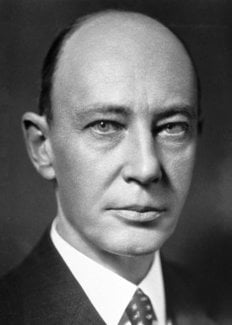George R. Minot
Biographical

George Richards Minot was born on December 2, 1885, at Boston, Massachusetts, U.S.A. His ancestor, George Minot, had migrated to America in 1630, from Saffron Walden, England. His father, James Jackson Minot, was a physician, and his mother was Elizabeth Whitney.
In his youth Minot was interested in butterflies and moths, and he published two articles on butterflies. He went to Harvard University and there took his A.B. degree in 1908, his M.D. in 1912, and gained an honorary degree of Sc.D. in 1928.
He did his hospital training at the Massachusetts General Hospital and then worked at Johns Hopkins Hospital and Medical School, under W. S. Thayer and W. H. Howell.
In 1915 he was appointed Assistant in Medicine at the Harvard Medical School and the Massachusetts General Hospital and was later appointed to a more senior post there.
In 1922 he became Physician-in-Chief of the Collis P. Huntington Memorial Hospital of Harvard University, and later was appointed to the Staff of the Peter Bent Brigham Hospital.
In 1928 he was elected Professor of Medicine at Harvard University and Director of the Thorndike Memorial Laboratory and Visiting Physician to the Boston City Hospital.
Minot early became, when he was a medical student, interested in the disorders of the blood with which his name is associated and he published during his life many papers on this and other subjects. Arthritis, cancer, dietary deficiencies, the part played by diet (vitamin B deficiency) in the production of so-called alcoholic polyneuritis and the social aspects of disease were among the subjects of his papers. Further he studied the coagulation of the blood, blood transfusion, the blood platelets and the reticulocytes as well as certain blood disorders, and he described an atypical familial haemorrhagic condition associated with prolonged anaemia. He also studied the condition of the blood in certain cases of industrial poisoning.
Among his other interests were leucaemia, disorders of the lymphatic tissues and polycythaemia, but his most important contributions to knowledge were made in his studies of anaemia. His name will always be associated with the therapy of pernicious anaemia, in which he first became interested in 1914, but it was not until later that he, like William P. Murphy, became impressed by the work of George Hoyt Whipple on the treatment of experimental forms of anaemia in dogs, and in 1926 he and Murphy described the effective treatment of pernicious anaemia by means of liver. For this work he and Murphy and Whipple were awarded, in 1934, the Nobel Prize for Physiology or Medicine. Subsequently, Minot, in collaboration with Edwin J. Cohn, extended this work by showing the efficacy of certain fractions of liver substance and he demonstrated the value of reticulocyte reactions in the evaluation of therapeutic procedures. He also added to knowledge of gastro-intestinal functions and of iron therapy for anaemia, and to knowledge of other aspects of this group of diseases.
Minot was member or fellow of numerous medical and allied organizations in his own country and abroad, and served as Editor of several medical publications. Among the many honours and distinctions he received, may be mentioned: the Cameron Prize in Practical Therapeutics of the University of Edinburgh, in 1930 (jointly with W. P. Murphy), the Popular Science Monthly Gold Medal and Annual Award for 1930 (jointly with G. H. Whipple), and the John Scott Medal of the City of Philadelphia.
On June 29, 1915, Minot married Marian Linzee Weld; there were two daughters and one son by this marriage.
After a long and busy life, during which he made many important contributions to medical knowledge, especially to that of diseases of the blood, Minot died, full of honours, in 1950.
This autobiography/biography was written at the time of the award and first published in the book series Les Prix Nobel. It was later edited and republished in Nobel Lectures. To cite this document, always state the source as shown above.
George R. Minot died on February 25, 1950.
The Nobel Foundation's copyright has expired.Nobel Prizes and laureates
Six prizes were awarded for achievements that have conferred the greatest benefit to humankind. The 12 laureates' work and discoveries range from proteins' structures and machine learning to fighting for a world free of nuclear weapons.
See them all presented here.
